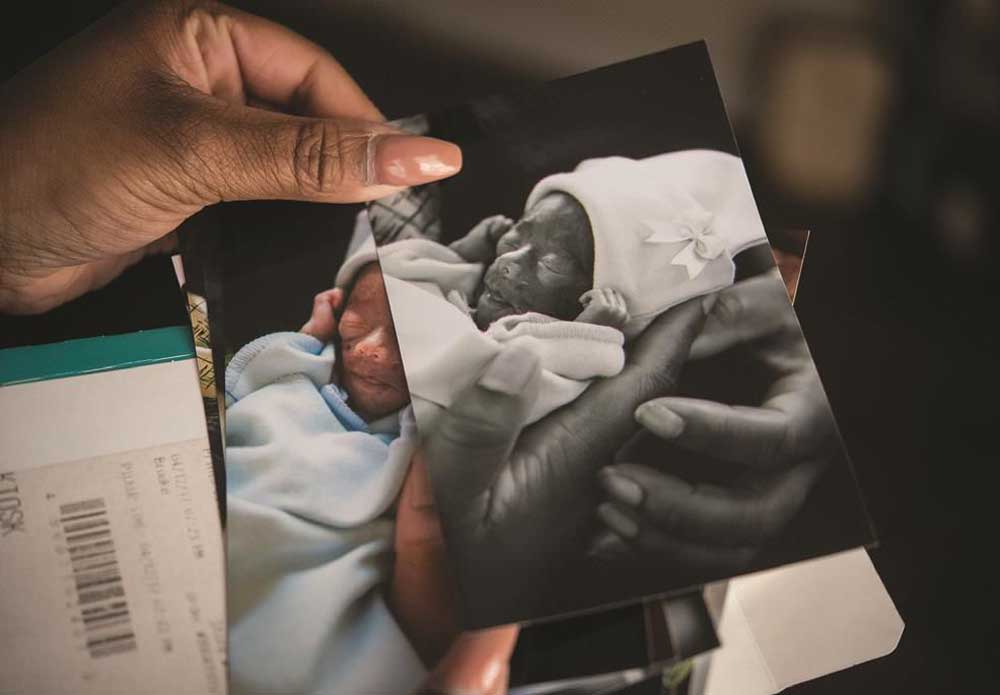After trying to do everything right, ‘sneaky’ preeclampsia took her child
Published 2:40 am Sunday, May 12, 2019

- She looks at the photographs she has of her child, who was born prematurely after Wade experienced a pregnancy emergency.
At only 24 weeks into her pregnancy, 25-year-old Tasha Wade of Tyler underwent emergency cesarean section surgery due to a complication called preeclampsia to deliver her son and potentially save her life.
She named the 1-pound, 8-ounce boy Oa’siah.
“It means strong,” she said.
Oa’siah died two days later on March 12, 2017.
For black babies across Texas, the infant mortality rate is twice as high as the rate for white infants and Hispanic infants. In other parts of the United States the rate is three to four times higher.
In Texas, the most common cause of infant death for black babies is short gestation (prematurity) and low birth rate.
Black mothers face higher rates of maternal morbidity than any other racial or ethnic group in Texas, according to the Texas Health
and Human Services’ Regional Analysis of Maternal and Infant Health in Texas report.
The infant mortality rate for the region that encompasses 35 Northeast Texas counties, including the areas of Tyler-Jacksonville and Longview-Marshall, was 7.2 deaths per 1,000 births in 2015.
The Tyler-Jacksonville area had the highest rate among all large communities in Texas at 9.7 deaths per 1,000, almost double the state rate of 5.6 per 1,000.
Wade and her boyfriend had been together for three years when Oa’siah was born. In the beginning stages of her pregnancy, everything was going well. She went to her prenatal doctor’s appointments, took prenatal vitamins.
She had a mentor in a pregnancy support group at Green Acres Baptist Church called Embrace Grace. She received weekly home visits from a nurse through the Nurse-Family Partnership program of UT Health East Texas for first-time moms.
‘SNEAKY AND QUICK’
Things were going well until the day her legs began to swell and her breathing became difficult.
She was admitted into a hospital. She said hospital staff told her that her blood pressure was so high that she could have had a stroke or seizures. She had fluid on her brain and in her legs. She had protein in her urine, a sure sign of the pregnancy complication preeclampsia, which is a form of hypertension (high blood pressure).
Texas Health and Human Services reports that the rate of maternal hypertension in Northeast Texas is the highest among all regions in Texas.
“They came in my room the next morning and told me they were taking him out that night because if they don’t they might lose both of us,” Wade said.
Wade regrets not having her urine checked at every doctor’s visit to monitor for protein.
“I want to say that preeclampsia is sneaky and quick,” she said. “I had been seeing a doctor. My blood pressure was fine two days before my legs started to swell.”
The causes and cures for preeclampsia are somewhat unknown. Factors that increase the risk include being African American, having a family history of the disorder, being obese and having diabetes or high blood pressure.
Wade also was under a lot of stress before and during her pregnancy. Her mother recently had passed away. Her relationship with her boyfriend was starting to fall apart. She was working long hours at her job in housekeeping and coming to the realization that she might become a single mom.
The American College of Obstetricians and Gynecologists last year reaffirmed a 2015 committee opinion encouraging OB-GYNs and other health care providers to engage in activities to help eliminate racial and ethnic disparities in the health and health care of women. The organization cites a study from the Institute of Medicine showing that factors such as stereotyping and implicit bias by health care providers may contribute to the racial disparities in health.
A separate study by Lisa Rosenthal and Marci Lobel titled “Explaining Racial Disparities in Adverse Birth Outcomes: Unique Sources of Stress for Black American Women” says that experiences of racism and life stressors likely affect maternal and infant health outcomes.
For many preeclampsia patients, treatment starts to become effective after the baby is born, but Wade remained sick with preeclampsia symptoms of high blood pressure and swelling in her legs weeks after her delivery.
To see Oa’siah she was wheeled to the neonatal intensive care unit at Christus Mother Frances in her hospital bed. He was so fragile that she was not allowed to hold him, but she could softly place her finger on his stomach. He was the size of a small baby doll with delicate skin and lungs that had not fully developed.
On his second day of life, Wade was in her hospital room when she heard a call for staff needed in the NICU.
‘IT WAS MY BABY’
“I said, ‘Bless their heart for whoever’s baby that is,’ then I got a call in my room that I need to come to the NICU ASAP. It was my baby.”
Wade was allowed to hold him as he died. She sang him the Bruno Mars’ song “Just the Way You Are,” the same song she sang to him in her belly. She was in denial of his death because she was born prematurely herself and survived.
“I didn’t want to let him go,” she said.
She held him as long as she could, then she gave him his first bath and some clothes.
“I never got to change his diaper,” she said, “I never got to hear his cries. I don’t know what he would have sounded like. He barely opened one eye when I was holding him, but I know he had brown eyes.”
Wade was able to briefly leave the hospital for Oa’siah’s funeral and memorial service, but she returned quickly as she was still sick.
Before she recovered, her boyfriend left her without a phone call or a reason why. Later she found out that he felt guilty for the stress he caused her. He felt like he was to blame for the loss of their child.
When she went to get her surgery stitches removed the medical staff noticed that her blood pressure was too high, her heart rate was too low and she was very tired.
“They asked me if I was trying to commit suicide by overdosing,” Wade said. “I was taking the pills as prescribed.”
Wade was angry with God after her loss, but she remained strong. She knew it was OK to feel the pain and anger she felt.
She now channels her thoughts into poetry and video blog posts. She has a YouTube channel called “Tash’s Journey” where she shares her poems and updates viewers on her life.
Wade still keeps in touch with her Embrace Grace mentor, Ellen Winegeart, 62, of Tyler. Winegeart will never forget receiving the phone call from Wade that she was about to undergo a C-section.
“I told my husband, Glen, to take me straight to the hospital,” Winegeart said. “Tasha really had no one at the time.”
Winegeart said that many of her mentees don’t have family support in their pregnancy.
“Those are the girls that I really step up and walk with,” she said. “I was there to love on Tasha after Oa’siah was born. Getting to walk in her journey with her has been an honor.”
Embrace Grace typically celebrates group members with a baby shower or adoption celebration. Since Wade lost her child, the group decided to purchase a memorial stone for Oa’siah at The Children’s Park in Tyler. Winegeart and Wade have met there the past two years for Oa’siah’s birthday. The park is a place where children can play and parents can come to commemorate children who have died. Glen Winegeart and a friend were the ones who dug Oa’siah’s grave at a family cemetery plot. Ellen Winegeart provided the baby boy’s funeral clothes.
THE FUTURE
Wade, now 27, has her certified nurse assistant (CNA) degree from Tyler Junior College, and she’s completing Texas A&M University’s Community Health Worker certification program online. After she gets her certificate, she plans to go back to school for her registered nurse degree.
With her Community Health Worker certificate, her long-term goal is to start her own nonprofit to help women who are pregnant or trying to conceive and their partners. She believes that it’s vital for men to get involved in their partner’s prenatal visits, too. She wants women to have the knowledge of how to eat and live healthy during pregnancy, but also before they become pregnant and after.
She wants men to ask the doctors questions about signs and symptoms of complications.
“When I’m ready, hopefully I’ll be a mom again, but I’m still a mom now,” she said. “Just because he’s not here doesn’t mean I’m not a mom. I still celebrate Mother’s Day. Even when people ask me if I have kids, I don’t say, ‘I had a son.’ I say, ‘I have a son. He’s 2 years old.’ I say it like he’s here.”
TWITTER: @TMT_Sarah
INFANT MORTALITY
The Centers for Disease Control and Prevention reported that in 2017 the infant mortality rate in the United States was 5.8 deaths per 1,000 live births, which is higher than other developed nations, and the rate of death for black infants is more than twice that for white babies. The top reasons for infant deaths before age 1 are: birth defects, preterm birth and low weight, maternal pregnancy complications, sudden infant death syndrome and injuries. In 2016, infant mortality rates in the U.S. per 1,000 live births by race and ethnicity were as follows:
• black: 11.4
• American Indian/Alaska Native: 9.4
• Native Hawaiian or other
• Pacific Islander: 7.4
• Hispanic: 5.0
• white: 4.9
• Asian: 3.6
WHAT IS PREECLAMPSIA?
Preeclampsia is a pregnancy complication characterized by high blood pressure. Typically, preeclampsia occurs after 20 weeks gestation (in the late second or third trimesters or middle to late pregnancy) and up to six weeks postpartum (after delivery).
Globally, preeclampsia and other hypertensive disorders of pregnancy are a leading cause of maternal and infant illness and death. These disorders are responsible for 76,000 maternal and 500,000 infant deaths each year around the world. The causes and cures are unknown.
According to the March of Dimes, in the United States it’s the cause of 15 percent (about 3 in 20) of premature births. The Preeclampsia Foundation lists signs and symptoms including:
• high blood pressure (hypertension)
• changes in vision
• headache
• nausea
• shoulder pain
• abdominal pain
• sudden weight gain
• protein in urine
• swelling in legs, hands or face
• shortness of breath or anxiety
The March of Dimes lists several risk factors:
• preeclampsia in a previous pregnancy
• pregnant with multiples (twins, triplets or more)
• high blood pressure, diabetes, kidney disease or an autoimmune disease like lupus
• never had a baby before, or more than 10 years since you had a baby
• obesity
• family history of preeclampsia.
• complications in a previous pregnancy, such as low birthweight.
• low socioeconomic status.
• in vitro fertilization fertility treatment
• older than 35
African American women are at higher risk for preeclampsia than other women.
To screen for preeclampsia, have your provider measure your blood pressure and test your urine for protein at every prenatal visit.
Texas Health and Human Services recommends the following interventions to help reduce the infant mortality rate in Northeast Texas: healthy weight gain during pregnancy, reduce teen pregnancy, reduce premature births, reduce parental smoking, increase rates of breastfeeding and increase access to prenatal care.
“When I’m ready, hopefully I’ll be a mom again, but I’m still a mom now. Just because he’s not here doesn’t mean I’m not a mom. I still celebrate Mother’s Day.”
TASHA WADE






